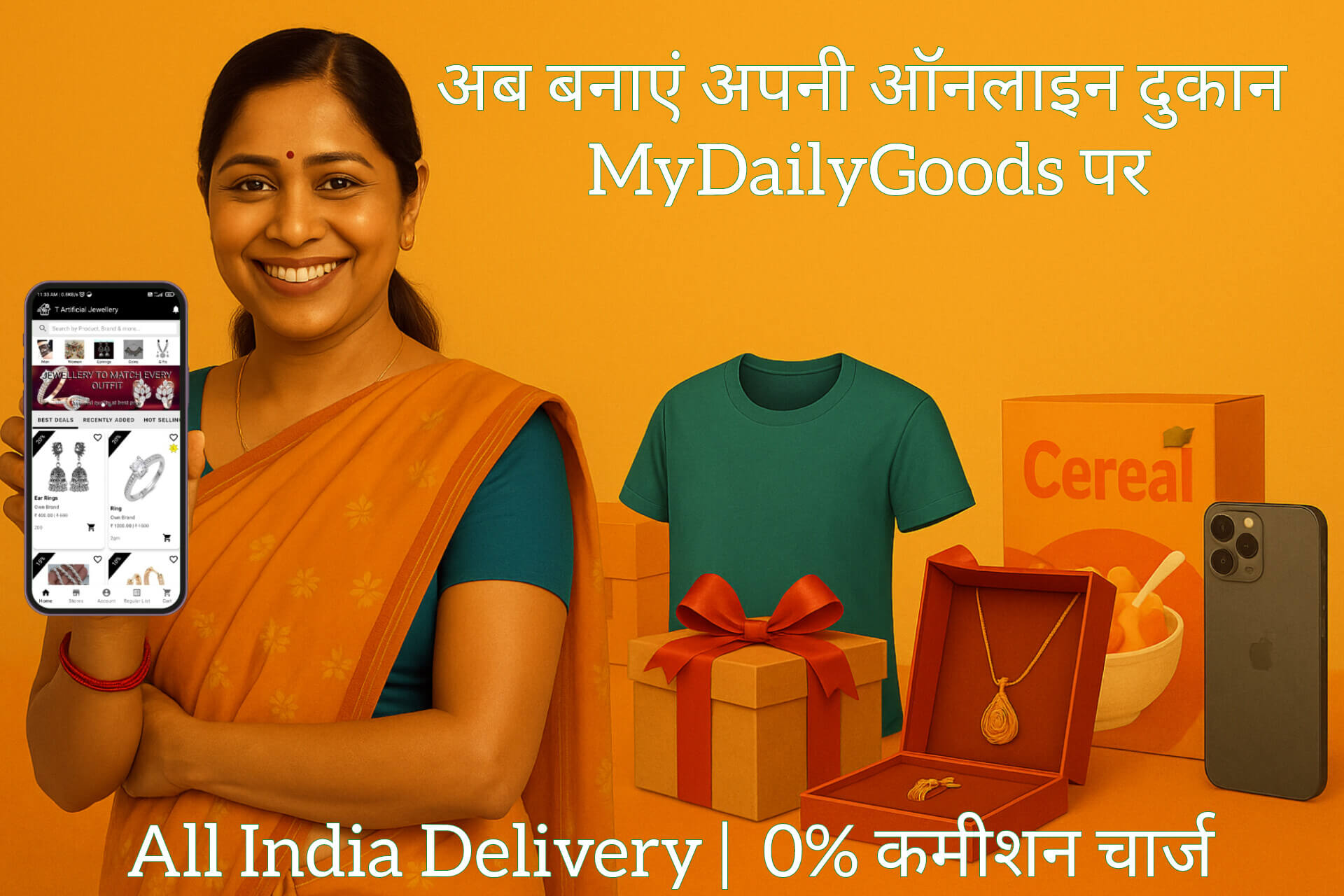
Selling products online has become a popular and effective way to reach customers worldwide. Whether you're a small business owner, an entrepreneur, or a hobbyist looking to turn your passion into profit, understanding how to sell products online is essential. This guide will walk you through the steps of setting up an online store, choosing the right platform, marketing your products, and ensuring customer satisfaction. MyDailyGoods is a great platform to start your online journey. We will know more about it but before let’s know the steps before setting up your online store.
Before you start selling products online, deciding what products to offer is the foundation of your online business. The first step in this process is aligning your product choices with your interests and expertise. Selling products that you are passionate about and knowledgeable in will not only make the process more enjoyable but also increase your credibility and ability to market them effectively. Your enthusiasm for your products can significantly enhance customer interactions and drive sales.
Understanding market demand is essential for selecting products with high sales potential. Use keyword research tools such as Google Keyword Planner to determine how frequently certain products are searched for online. This will give you a clear picture of what consumers are interested in and willing to buy. Additionally, consider the competitive landscape: while high-demand products appeal, entering an oversaturated market can be challenging. Look for niches with steady demand but less competition, which can offer growth opportunities.
Finally, ensure that the products you choose solve a problem or meet a specific need for your target audience. Products that provide practical solutions or fulfil niche requirements tend to attract loyal customers and generate positive word-of-mouth. Evaluate the practicality and logistics of sourcing, storing, and shipping these products, as these factors will impact your overall profitability. By addressing a clear market need with well-researched, in-demand products that you are passionate about, you set a strong foundation for a successful online business.
Knowing your target audience is crucial for effective marketing, especially when you create a website to sell products online. The first step in this process is to develop a detailed buyer persona. A buyer persona is a semi-fictional representation of your ideal customer based on market research and real data about your existing customers. It includes key demographics such as age, gender, income level, education, and deeper insights into their interests, hobbies, and lifestyle. By understanding who your customers are, you can design a website that appeals directly to them and offers a user experience that resonates with their preferences and needs.
Creating a buyer persona also involves analyzing your audience's buying behaviour. This means looking at how they shop, what influences their purchasing decisions, and what barriers might prevent them from making a purchase. For instance, do they prefer online shopping late at night? Are they influenced by social media reviews or email newsletters? Understanding these patterns helps you to tailor your marketing strategies effectively. When you know your audience's behaviour, you can optimize your website’s layout, product descriptions, and checkout process to align with their shopping habits, thereby improving conversion rates.
Tailoring your marketing strategies and product offerings to meet your target audience’s needs ensures that your efforts are not wasted. For example, if your buyer persona shows that your audience values sustainability, you can highlight eco-friendly products on your website and emphasize green practices in your marketing campaigns. Personalized marketing messages, such as targeted emails or social media ads, can directly address the specific needs and pain points of your audience. This level of customization fosters a deeper connection with your customers, increases brand loyalty, and drives more sales. By focusing on your target audience, you create a more engaging and effective online shopping experience, positioning your business for long-term success.
Choosing the right e-commerce platform is vital to your online selling success. Popular options include Shopify, WooCommerce, BigCommerce, and Etsy, each offering unique features and benefits. When selecting a platform, consider factors such as ease of use, customization options, scalability, and cost. Your chosen platform should align with your business goals and technical expertise.
One highly recommended option for new and small business owners is MyDailyGoods. This platform allows you to create a website to sell products online in just 15 minutes. MyDailyGoods stands out because it is free to set up and the first 15 days are completely free, providing a risk-free opportunity to get your online store up and running. After the trial period, there are bare minimum charges that make it an affordable choice for startups and small businesses.
MyDailyGoods is designed with user-friendliness in mind, requiring no coding knowledge to create a professional-looking website. This ease of use ensures that even those with no technical background can quickly set up and manage their online store. Additionally, MyDailyGoods provides robust customer support and a range of tools to help you optimize your site and boost sales, making it a versatile and accessible option for anyone looking to enter the e-commerce space.
Your product listings should be detailed and persuasive. Include high-quality images, thorough descriptions, and clear pricing. Highlight the benefits and features of each product. Use keywords to improve search engine optimization (SEO) and attract more traffic.
Setting the right price is essential. Research your competitors and consider your costs, including production, shipping, and marketing. Your pricing should be competitive but also allow for a healthy profit margin. Experiment with different pricing strategies like discounts and bundles.
Offering multiple payment options is essential to accommodate different customer preferences and enhance the shopping experience. Common payment methods include credit/debit cards, PayPal, and digital wallets like Apple Pay and Google Wallet. However, when using MyDailyGoods to create your online store, you can simplify this process significantly.
With MyDailyGoods, you don't need to worry about setting up and integrating external payment gateways. The platform comes with its own built-in payment gateway, making it incredibly convenient and user-friendly. All you need to do is add your bank account details, and your payment gateway is ready to go. This streamlined setup ensures that you can start accepting payments immediately without the technical complexities or additional costs associated with third-party payment processors.
Moreover, MyDailyGoods offers a quick remittance period of just 2 days, ensuring that you receive your funds promptly. This efficient payment processing helps maintain cash flow and supports your business operations, allowing you to focus more on selling and less on administrative tasks. By providing a secure and reliable payment gateway built into the platform, MyDailyGoods makes managing your online store simpler and more efficient.
Effective shipping and logistics are crucial for customer satisfaction and can significantly influence repeat business. Choosing reliable shipping partners and offering various shipping options, such as standard, expedited, and international shipping, ensures that you meet diverse customer needs. Clearly communicating shipping costs and delivery times on your website helps manage customer expectations and reduces cart abandonment rates.
When you create your online store with MyDailyGoods, you have flexible shipping options that can be tailored to your business model and customer preferences. MyDailyGoods provides three primary shipping methods: self-pickup, your own delivery service, and MDG delivery. This flexibility allows you to choose the best approach based on your resources and customer demands.
i) Self-Pickup: For local customers, self-pickup can be a convenient and cost-effective option. You can set up a designated pickup location where customers can collect their orders at their convenience. This option not only saves on shipping costs but also encourages local community engagement.
ii) Your Own Delivery: If you can handle deliveries, you can manage your own delivery service. This allows you to maintain control over the delivery process, ensuring that orders are handled with care and delivered promptly. You can offer same-day or next-day delivery services to attract local customers who need quick turnaround times.
iii) MDG Delivery: For those who prefer to outsource logistics, MyDailyGoods offers a third-party delivery service. MDG Delivery is a reliable option that handles the entire shipping process for you. This service includes various shipping options, such as standard and expedited shipping, ensuring that your customers receive their orders promptly. MyDailyGoods’ delivery service integrates seamlessly with your online store, providing real-time tracking and updates to keep your customers informed.
By offering multiple shipping options through MyDailyGoods, you can cater to a wider range of customer preferences and enhance the overall shopping experience. Whether you choose self-pickup, manage your own deliveries, or utilize MDG Delivery, ensuring efficient and transparent logistics will help build trust and loyalty among your customers.
Marketing is key to driving traffic to your online store. Utilize a mix of digital marketing strategies, including social media marketing, email marketing, content marketing, and search engine marketing (SEM). Regularly post engaging content and interact with your audience on social media platforms.
Social media platforms like Facebook, Instagram, and Twitter are powerful tools for reaching potential customers. Share product updates, promotions, and user-generated content. Use targeted ads to reach a specific audience and increase brand visibility.
Build an email list and send regular newsletters to keep your audience informed about new products, special offers, and upcoming events. Personalize your emails and include compelling calls to action to encourage purchases.
Optimize your website and product listings for search engines to increase organic traffic. Create valuable content such as blog posts, tutorials, and videos related to your products. This will help establish your brand as an authority and attract more visitors.
In addition to your online store, consider selling on marketplaces like Amazon, eBay, and Etsy. These platforms have a large customer base and can help you reach a wider audience. Be mindful of the fees and competition on these platforms.
Efficient inventory management ensures that you can meet customer demand without overstocking. Use inventory management software to track stock levels, manage orders, and forecast demand. Regularly review your inventory to avoid shortages or excess stock.
Customer service is critical for building trust and loyalty. Respond promptly to customer inquiries, offer easy returns and refunds, and seek feedback to improve your products and services. Positive reviews and word-of-mouth can significantly boost your sales.
Regularly analyze your sales data and website analytics to understand your performance. Identify which products are performing well and which need improvement. Use tools like Google Analytics to track website traffic, user behaviour, and conversion rates.
As your business grows, consider scaling up by expanding your product line, entering new markets, or investing in more advanced marketing strategies. Continuously innovate and adapt to market changes to stay competitive.
Selling products online is a dynamic and rewarding endeavour. By choosing the right products, understanding your audience, and effectively marketing your online store, you can build a successful e-commerce business. Stay committed, continuously improve your strategies, and always prioritize your customers to achieve long-term success.




